Former Presidents of Bemidji State University
Since its establishment in 1919, Bemidji State University has had 17 presidents.
Faith C. Hensrud, 2016-2022
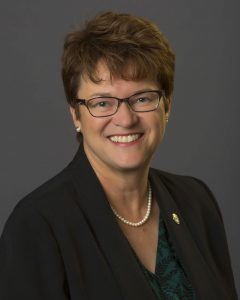 Dr. Faith C. Hensrud was announced as the president of Bemidji State University and Northwest Technical College on April 20, 2016, assuming the role on July 1 of that year. Her tenure was defined by extensive strategic planning processes, broad-ranging successes in forging new partnerships and a diligent emphasis on social justice. She also renewed BSU’s commitment to environmental sustainability by joining the Campus Climate Commitment.Her efforts to improve the connections with the region’s Indigenous nations led to the creation of American Indian Advisory Councils for both BSU and NTC. Under her leadership, BSU also signed dual-enrollment agreements with all four Minnesota tribal colleges and led a process to craft an acknowledgment of BSU’s campus location on ancestral homelands of the Ojibwe and Dakota people. At NTC, a partnership between the Northwest Minnesota Foundation and NTC Foundation have led to significantly increased scholarship support for NTC students. NTC also expanded its partnerships with area high schools, teaching nursing and plumbing courses on high school campuses and opened its Student Success Center which significantly increased access to tutoring and other student support services.Both campuses also enjoyed extensive renovations under Hensrud’s leadership. At Bemidji State, a decade-long dream to replace Hagg-Sauer Hall was finally realized in 2020. A new building, which won numerous awards for government construction projects, was part of an extensive campus renovation project which re-imagined space in four other academic buildings. At NTC, a new commercial refrigeration lab highlighted significant renovations to labs for the college’s automotive, electrical construction and nursing programs.
Dr. Faith C. Hensrud was announced as the president of Bemidji State University and Northwest Technical College on April 20, 2016, assuming the role on July 1 of that year. Her tenure was defined by extensive strategic planning processes, broad-ranging successes in forging new partnerships and a diligent emphasis on social justice. She also renewed BSU’s commitment to environmental sustainability by joining the Campus Climate Commitment.Her efforts to improve the connections with the region’s Indigenous nations led to the creation of American Indian Advisory Councils for both BSU and NTC. Under her leadership, BSU also signed dual-enrollment agreements with all four Minnesota tribal colleges and led a process to craft an acknowledgment of BSU’s campus location on ancestral homelands of the Ojibwe and Dakota people. At NTC, a partnership between the Northwest Minnesota Foundation and NTC Foundation have led to significantly increased scholarship support for NTC students. NTC also expanded its partnerships with area high schools, teaching nursing and plumbing courses on high school campuses and opened its Student Success Center which significantly increased access to tutoring and other student support services.Both campuses also enjoyed extensive renovations under Hensrud’s leadership. At Bemidji State, a decade-long dream to replace Hagg-Sauer Hall was finally realized in 2020. A new building, which won numerous awards for government construction projects, was part of an extensive campus renovation project which re-imagined space in four other academic buildings. At NTC, a new commercial refrigeration lab highlighted significant renovations to labs for the college’s automotive, electrical construction and nursing programs.
In addition, both BSU and NTC had successful accreditation visits with the Higher Learning Commission. BSU’s accreditation was reaffirmed by the commission through 2030, and NTC had a successful mid-cycle accreditation review in 2020.
Most importantly, Hensrud guided both BSU and NTC safely through the first 18 months of the COVID-19 pandemic. Both campuses shared in the wide-ranging disruptions caused by the pandemic and various mitigation strategies. However, due in part to their shared pandemic response, at the time of her retirement neither BSU nor NTC had a confirmed case of COVID-19 as a result of on-campus spread and no employees or students had been lost to the virus.
Prior to her tenure as BSU & NTC president, Hensrud served in a variety of roles at the University of Wisconsin-Superior for nearly 20 years. She joined the faculty in 1995 as a lecturer in its Department of Business and Economics, and later would serve as leader of the school’s distance education and continuing education programs; associate vice chancellor for academic affairs and outreach; interim provost and vice chancellor for academic affairs and dean of faculties; and finally as provost and vice chancellor for academic affairs. She held that position for four years before moving to Bemidji.
She also Is a U.S. Army veteran, serving on active duty with the 24th Transportation Battalion at Ft. Eustis, Virginia, from 1986-89 and as a member of the U.S. Army Reserve from 1989-2000.
Richard A. Hanson, 2010-2016
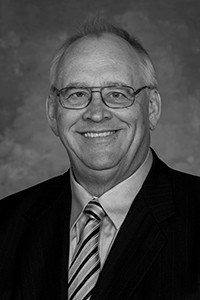 Dr. Richard Hanson served as president of Bemidji State University and Northwest Technical College from July 2010-June 2016. Among his accomplishments, Dr. Hanson implemented a broad restructuring of course offerings at Bemidji State University and Northwest Technical College in an effort to adapt to current market conditions, resulting in increased competitiveness for both institutions. He ushered in a new era in men’s and women’s athletics, when in 2010, the BSU Beavers opened a new arena for the start of Division I WCHA hockey. With the help of the student body, Dr. Hanson implemented a tobacco-free policy on both campuses. In addition, he founded the Bemidji School of Nursing, coordinating the instructional efforts of both NTC and BSU. He renamed the Education-Arts building as Bensen Hall, in honor of President Emeritus James Bensen.
Dr. Richard Hanson served as president of Bemidji State University and Northwest Technical College from July 2010-June 2016. Among his accomplishments, Dr. Hanson implemented a broad restructuring of course offerings at Bemidji State University and Northwest Technical College in an effort to adapt to current market conditions, resulting in increased competitiveness for both institutions. He ushered in a new era in men’s and women’s athletics, when in 2010, the BSU Beavers opened a new arena for the start of Division I WCHA hockey. With the help of the student body, Dr. Hanson implemented a tobacco-free policy on both campuses. In addition, he founded the Bemidji School of Nursing, coordinating the instructional efforts of both NTC and BSU. He renamed the Education-Arts building as Bensen Hall, in honor of President Emeritus James Bensen.
He oversaw the development of an academic master plan as part of the strategic plan for both institutions. All the while, he worked assiduously on an extensive capital campaign to raise funding for student scholarships and endowments, exceeding the $35 million goal.
Jon E. Quistgaard, 2001-2010
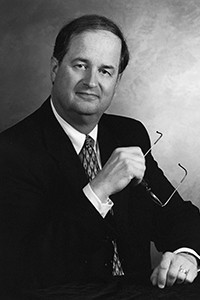 Jon E. Quistgaard served as President of Bemidji State University from August 2001-July 2010. Prior to his presidency, Quistgaard served as Dean of Graduate Studies, Associate Vice President for Academic Affairs and Vice President for Academic and Student Affairs. Quistgaard started his career at the University of Arizona, where he earned his Doctorate in Political Science. During his tenure at Bemidji State, there were major changes in technology, enrollment, funding and diversity. Most notably, the school diversified to include students from more than 30 states and 40 countries. Quistgaard recalls seeing more adults and military veterans seeking opportunities to further their education. Additionally, Northwest Technical College was stabilized during his time. Quistgaard was known for being approachable and friendly to students and staff, who came to know him as “Q.” Quistgaard believed deeply in the values of the university, and once said that “The true greatness of both these institutions is still in front of us.”
Jon E. Quistgaard served as President of Bemidji State University from August 2001-July 2010. Prior to his presidency, Quistgaard served as Dean of Graduate Studies, Associate Vice President for Academic Affairs and Vice President for Academic and Student Affairs. Quistgaard started his career at the University of Arizona, where he earned his Doctorate in Political Science. During his tenure at Bemidji State, there were major changes in technology, enrollment, funding and diversity. Most notably, the school diversified to include students from more than 30 states and 40 countries. Quistgaard recalls seeing more adults and military veterans seeking opportunities to further their education. Additionally, Northwest Technical College was stabilized during his time. Quistgaard was known for being approachable and friendly to students and staff, who came to know him as “Q.” Quistgaard believed deeply in the values of the university, and once said that “The true greatness of both these institutions is still in front of us.”
M. James Bensen, 1994-2001
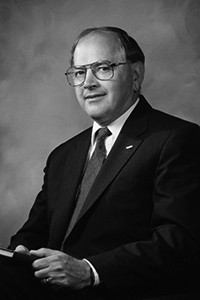 James Bensen was selected as the next President of Bemidji State University by a unanimous vote and began his presidency on July 1, 1994. President Bensen was the eighth permanent president of the university. Bensen was born on April 8, 1937, in Erskine, Minnesota. He graduated from Bemidji State University with a degree in Industrial Education and Physical Education. He then went on to the University of Wisconsin-Stout to pursue his Master’s degree in Industrial Education, Administration, Supervision and Curriculum. Bensen received his doctorate from Pennsylvania State University in Curriculum, Administration and Educational Development in 1967. Prior to serving Bemidji State University, Bensen served as president at Dunwoody Institute, a private, non-profit school in Minneapolis. He had also served as the Dean of the School of Industry and Technology at the University of Wisconsin-Stout. James Bensen served Bemidji State University as president for seven years, until he retired in July 2001. After retiring, he became President Emeritus and continues to support STEM (Science, Technology, Engineering and Mathematics) programs.
James Bensen was selected as the next President of Bemidji State University by a unanimous vote and began his presidency on July 1, 1994. President Bensen was the eighth permanent president of the university. Bensen was born on April 8, 1937, in Erskine, Minnesota. He graduated from Bemidji State University with a degree in Industrial Education and Physical Education. He then went on to the University of Wisconsin-Stout to pursue his Master’s degree in Industrial Education, Administration, Supervision and Curriculum. Bensen received his doctorate from Pennsylvania State University in Curriculum, Administration and Educational Development in 1967. Prior to serving Bemidji State University, Bensen served as president at Dunwoody Institute, a private, non-profit school in Minneapolis. He had also served as the Dean of the School of Industry and Technology at the University of Wisconsin-Stout. James Bensen served Bemidji State University as president for seven years, until he retired in July 2001. After retiring, he became President Emeritus and continues to support STEM (Science, Technology, Engineering and Mathematics) programs.
Linda L. Baer, Interim President, 1993-1994
Linda Louise Baer was born in Spokane, Washington on September 7, 1949. She was raised in Washington and began her post-secondary education at Washington State University, where she received both her Bachelor’s and Master’s degrees in Sociology. She obtained her Doctorate in Sociology from South Dakota State University. Before coming to Bemidji, Baer served many different areas at South Dakota State University, including director of the Center for Innovation Technology and Entrepreneurship, Administrative Associate in charge of data collection and strategic planning and Associate Professor in the rural Sociology department. Baer was the Senior Vice President for Academic and Student Affairs when Duly passed away. She was almost immediately chosen to serve as an interim president. Upon taking the position, Baer made it clear that she wanted to continue to build on the vision that President Duly had. President Baer was able to lead the school in its 75th anniversary. She announced that the theme was “Making a Difference.” The school began to have a larger and larger active alumni group that helped raise money for the school, reaching a record of 4,000 alumni in 1993. The school was becoming bigger and bigger, with a rising number of both minority students and transfer students. Baer helped Bemidji State to not only keep growing and becoming global, but she also helped modernize different buildings on campus. In the summer of 1993, Hobson Memorial Union underwent a renovation that brought in new places to eat and new activities to do. Wally’s also undergone some changes that included an after hour’s pizza and sub parlor and new lines at the all you can eat menus during the day. President Baer retired as president on June 30, 1994, but took the position as Senior Vice President of Academic and Student Affairs until 1997, when she took the position as Senior Vice Chancellor for Academic and Student Affairs at Minnesota State Colleges and Universities in Saint Paul.
Leslie C. Duly, 1990-1993
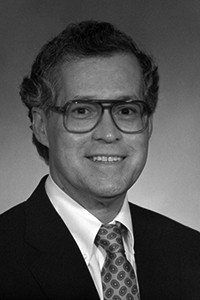 Leslie C. Duly was born on September 26, 1935, in Kenmore, New York. He was raised in the Kenmore area but then moved to the University of South Dakota to pursue his Bachelor’s degree in History. He then continued his schooling at the University of Melbourne, Australia, where he received his Master’s in History. Duly received his Doctorate in History from Duke University’s Commonwealth Studies Institute. After the completion of all his schooling, Duly taught at Memphis State University, Mount Holyoke College in South Kaley, Massachusetts and the University of Nebraska, Lincoln. At the University of Nebraska, Lincoln, he served as the director of University studies and received a special award for teaching excellence in the humanities. Duly started as the Vice President of Academic Affairs in Bemidji, where he was in charge of academic programs, cultural diversity programs, faculty development and international studies. Duly was a very easy going and happy man. He proved he cared for the university and the students by walking around, making conversation, filling coffee cups, scooping ice cream at socials and even bringing a cake to meetings. Duly wanted to be involved with the students as much as possible. After he became president on July 1, 1990, Duly said he wanted to spend a week living in Tamarack Hall, dining with students at Wally’s and listening to their concerns. Under Duly’s presidency, Bemidji State University was listed as the highest-ranked Minnesota State University in America’s Best Colleges. Duly also helped the school receive extra funding for things like summer programs for gifted Native American students, funds from NASA to continue a study on the effect of radiation on eye tissue and also a grant from the Ford Foundation, giving Bemidji $236,000 to be used towards a new program called “New Directions in Developing and Implementing a MulticulturalCurriculum: Models of Change and Transformation.” Duly was making some great changes to Bemidji State University, but sadly it all came to an end when Duly passed away due to a heart attack on May 8, 1993. The school held a memorial service where many people reminisced about all the great things Duly had accomplished at the school. He truly loved BSU, and it showed.
Leslie C. Duly was born on September 26, 1935, in Kenmore, New York. He was raised in the Kenmore area but then moved to the University of South Dakota to pursue his Bachelor’s degree in History. He then continued his schooling at the University of Melbourne, Australia, where he received his Master’s in History. Duly received his Doctorate in History from Duke University’s Commonwealth Studies Institute. After the completion of all his schooling, Duly taught at Memphis State University, Mount Holyoke College in South Kaley, Massachusetts and the University of Nebraska, Lincoln. At the University of Nebraska, Lincoln, he served as the director of University studies and received a special award for teaching excellence in the humanities. Duly started as the Vice President of Academic Affairs in Bemidji, where he was in charge of academic programs, cultural diversity programs, faculty development and international studies. Duly was a very easy going and happy man. He proved he cared for the university and the students by walking around, making conversation, filling coffee cups, scooping ice cream at socials and even bringing a cake to meetings. Duly wanted to be involved with the students as much as possible. After he became president on July 1, 1990, Duly said he wanted to spend a week living in Tamarack Hall, dining with students at Wally’s and listening to their concerns. Under Duly’s presidency, Bemidji State University was listed as the highest-ranked Minnesota State University in America’s Best Colleges. Duly also helped the school receive extra funding for things like summer programs for gifted Native American students, funds from NASA to continue a study on the effect of radiation on eye tissue and also a grant from the Ford Foundation, giving Bemidji $236,000 to be used towards a new program called “New Directions in Developing and Implementing a MulticulturalCurriculum: Models of Change and Transformation.” Duly was making some great changes to Bemidji State University, but sadly it all came to an end when Duly passed away due to a heart attack on May 8, 1993. The school held a memorial service where many people reminisced about all the great things Duly had accomplished at the school. He truly loved BSU, and it showed.
Lowell R. Gillett, 1982-1990
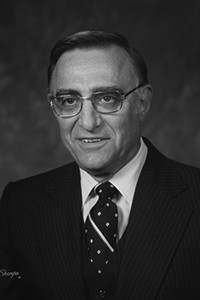 Lowell Reno “Ted” Gillett was born on February 23, 1925, in Minneapolis. Gillett attended and graduated from Gustavus Adolphus College with a major in English in 1947. He began his career as a teacher and coach at Amboy Public Schools. He later taught at Sherburn Public Schools for two years before becoming a teacher and assistant principal at Austin Public Schools in 1951, where he taught for 11 years. In 1962, Gillett decided he wanted to further his education at the University of North Dakota. After his second session of schooling, he served at St. Cloud University in several different fields, from being named professor of educational psychology to serving as vice president for academic affairs and the universities interim president. On August 1, 1982, Ted Gillett became Bemidji States’ sixth president. His time as president was highlighted by student-centered construction and renovation projects. One of his constructions was the building of the Gillett Recreation and Fitness Center, which is named in his honor, and considered by some as: “perhaps the single most significant physical improvement in making the campus more attractive to students.” Gillett was also successful in renovating Pine Hall into apartments for students who were single parents in 1990. Today, Cedar Hall is used as the building for single parents to live in with their children, while Pine Hall houses freshmen. Also, the Alumni Arch outside of Deputy Hall was established, which has become the university’s most distinguished landmark and serves as the unofficial gateway to campus. Ted Gillett was considered a very public man. He attended all campus events, along with events that took place in the community. Gillett retired as president in 1990 and passed away 21 years later at age 86 on October 9, 2011.
Lowell Reno “Ted” Gillett was born on February 23, 1925, in Minneapolis. Gillett attended and graduated from Gustavus Adolphus College with a major in English in 1947. He began his career as a teacher and coach at Amboy Public Schools. He later taught at Sherburn Public Schools for two years before becoming a teacher and assistant principal at Austin Public Schools in 1951, where he taught for 11 years. In 1962, Gillett decided he wanted to further his education at the University of North Dakota. After his second session of schooling, he served at St. Cloud University in several different fields, from being named professor of educational psychology to serving as vice president for academic affairs and the universities interim president. On August 1, 1982, Ted Gillett became Bemidji States’ sixth president. His time as president was highlighted by student-centered construction and renovation projects. One of his constructions was the building of the Gillett Recreation and Fitness Center, which is named in his honor, and considered by some as: “perhaps the single most significant physical improvement in making the campus more attractive to students.” Gillett was also successful in renovating Pine Hall into apartments for students who were single parents in 1990. Today, Cedar Hall is used as the building for single parents to live in with their children, while Pine Hall houses freshmen. Also, the Alumni Arch outside of Deputy Hall was established, which has become the university’s most distinguished landmark and serves as the unofficial gateway to campus. Ted Gillett was considered a very public man. He attended all campus events, along with events that took place in the community. Gillett retired as president in 1990 and passed away 21 years later at age 86 on October 9, 2011.
Richard R. Haugo, Acting President, 1982
Richard Ronald Haugo was born July 11, 1925, in Ellendale, Minnesota. During World War II, he served on the U.S.S. Jason in the Pacific Theater. He then returned and worked in Minnesota doing road construction and then moved to Tacoma, Washington where he enrolled at Pacific Lutheran College and worked for American Smelting and Refining Company. He was then asked by the Mine, Mill and Smelter Workers’ Union to research a lung illness that was taking many workers’ lives. During his research, he outlined the physiological effect on the lungs from the arsenic vapor that was created during the smelting process. As a result of his research, affected workers were compensated and Richard Haugo’s name appeared on the Attorney General’s “blacklist.” During his life, it remained one of his proudest accomplishments. In 1958, he enrolled at Bemidji State College with a major in Industrial Education. He then moved to Grand Rapids, Michigan where he taught and attended night classes to earn his master’s in Education. In 1965, he began teaching Industrial Technology at Bemidji State College and later became the chair of the Industrial Technology Department. He then completed his master’s degree in Counseling in 1979 and began to help with the counseling in Student Affairs. In 1982, Richard Haugo was appointed as the Interim President of Bemidji State University and held the position from January to August. He then returned to Placement and Counseling, Educational Services until he retired in 1988. He passed away on January 22, 2009. The Richard R. Haugo scholarship was formed in memory of him.
Rebecca Stafford, 1980-1982
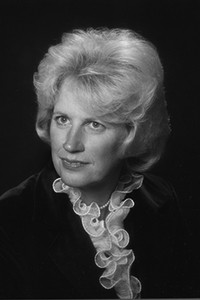 Rebecca Stafford was born on July 9, 1936, in Topeka, Kansas. She received her Bachelor’s degree in Sociology from Radcliffe College and then her Master’s and Doctoral degree in Sociology from Harvard University. She served as president of Bemidji State University from April 9, 1980, to December 16, 1981. Following her resignation, Rebecca Stafford announced she accepted the position of Executive Vice President of Colorado State University, Fort Collins.
Rebecca Stafford was born on July 9, 1936, in Topeka, Kansas. She received her Bachelor’s degree in Sociology from Radcliffe College and then her Master’s and Doctoral degree in Sociology from Harvard University. She served as president of Bemidji State University from April 9, 1980, to December 16, 1981. Following her resignation, Rebecca Stafford announced she accepted the position of Executive Vice President of Colorado State University, Fort Collins.
R.D. Decker, 1968-1980
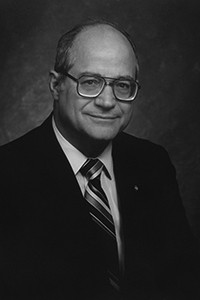 Robert David Decker was born on November 12, 1922, in Hayes County, Texas. He received his Bachelor’s, Master’s and Doctoral degrees from Texas A&M University, all of which were in the study of Agricultural Economics. Decker served as president for 12 years and was very influential in what was considered the “great expansion.” Eight buildings were built, three existing buildings were renovated and the enrollment hit an all-time high of 5,787 students. He also introduced a wide variety of new programs at the school, including computer science, criminal justice, technical illustration/graphic design, communication media and American Indian studies. The Center for Environmental Studies, the Foreign Studies Program and the Veterans Affairs Office were also created under his presidency. After retiring in September of 1979, Decker resumed teaching for about nine years, until deciding to run for Senate, which he served until 1990. The Decker family then moved to California in 1996. After battling Alzheimer’s for a number of years, Decker passed away at the age of 76 in Ventura, California on October 19, 1999.
Robert David Decker was born on November 12, 1922, in Hayes County, Texas. He received his Bachelor’s, Master’s and Doctoral degrees from Texas A&M University, all of which were in the study of Agricultural Economics. Decker served as president for 12 years and was very influential in what was considered the “great expansion.” Eight buildings were built, three existing buildings were renovated and the enrollment hit an all-time high of 5,787 students. He also introduced a wide variety of new programs at the school, including computer science, criminal justice, technical illustration/graphic design, communication media and American Indian studies. The Center for Environmental Studies, the Foreign Studies Program and the Veterans Affairs Office were also created under his presidency. After retiring in September of 1979, Decker resumed teaching for about nine years, until deciding to run for Senate, which he served until 1990. The Decker family then moved to California in 1996. After battling Alzheimer’s for a number of years, Decker passed away at the age of 76 in Ventura, California on October 19, 1999.
John S. Glas, Acting President 1967-1968
John Glas was born on October 1, 1910, in Waterloo, Iowa. He attended the University of Minnesota, earning his Bachelor’s degree in Business in 1933. Glas was involved at Bemidji State before his term as president. He was the Business Manager from 1939-1959. In 1957 he was the Assistant to the President for 11 years. He was also the Campus Executive Officer and the Vice-President for Administration. On May 1, 1967, John S. Glas became Acting President and held the position until September 1, 1968. In his honor, the John S. Glas Fieldhouse was named after him under the recommendation of the Men’s Physical Education Department. The John Glas Fieldhouse serves as a gymnasium for Bemidji State students and includes other athletic facilities.
Bevington Reed, Acting President 1967
Bevington Reed did not hold a permanent position at Bemidji State College. He only served as a very brief interim president after the death of President Bangsberg. On April 1, 1967, he was appointed as an acting president. During his time as president, he also had Bangsberg’s assistant John Glas serve as the Campus Executive Officer to handle the campus matters. Reed held the position until May 1, 1967, when he accepted a position in Texas.
Harry F. Bangsberg, 1964-1967
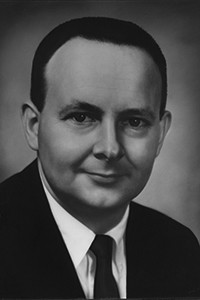 Harry Bangsberg was born on April 7, 1928, in Minneapolis, Minnesota. Bangsberg earned his Bachelor’s degree in History and English at Luther College in 1950. The following year, he attended the University of Iowa to achieve his Master’s Degree in History. He continued his studies at the University of Iowa in 1957 earning his Doctorates Degree. Bangsberg had several positions in the academic field. He first started out as an instructor for Social Studies at Western Illinois University in 1953-1955. In 1957 until 1959, Bangsberg was an Associate Professor in History at Wisconsin State University. He served as an Assistant Director at Wisconsin State University System of Madison in 1959-63. He was also an Executive Director and part of the Higher Education Coordinating Council at Metropolitan St. Louis from 1963-64. In 1965 Harry Bangsberg became President at Bemidji State. In 1967, he took a tour of Vietnam with seven other U.S. educators. The group was determined to assist the government of Vietnam in developing a higher education system. Bangsberg was on leave from Bemidji State for two months to Saigon. On March 23, 1967, a few weeks before their return home, the plane crashed in the mountains north of Da Nang. Bangsberg’s passing saddened the Bemidji State community deeply. Harry F. Bangsberg is honored through the Bangsberg of Fine Arts building located on campus.
Harry Bangsberg was born on April 7, 1928, in Minneapolis, Minnesota. Bangsberg earned his Bachelor’s degree in History and English at Luther College in 1950. The following year, he attended the University of Iowa to achieve his Master’s Degree in History. He continued his studies at the University of Iowa in 1957 earning his Doctorates Degree. Bangsberg had several positions in the academic field. He first started out as an instructor for Social Studies at Western Illinois University in 1953-1955. In 1957 until 1959, Bangsberg was an Associate Professor in History at Wisconsin State University. He served as an Assistant Director at Wisconsin State University System of Madison in 1959-63. He was also an Executive Director and part of the Higher Education Coordinating Council at Metropolitan St. Louis from 1963-64. In 1965 Harry Bangsberg became President at Bemidji State. In 1967, he took a tour of Vietnam with seven other U.S. educators. The group was determined to assist the government of Vietnam in developing a higher education system. Bangsberg was on leave from Bemidji State for two months to Saigon. On March 23, 1967, a few weeks before their return home, the plane crashed in the mountains north of Da Nang. Bangsberg’s passing saddened the Bemidji State community deeply. Harry F. Bangsberg is honored through the Bangsberg of Fine Arts building located on campus.
A.C. Clark, Acting President 1942-1946, 1964
A.C. Clark was the acting president for Charles Sattgast as he was on leave during WWII from 1942-1946 and also after Sattgast’s death from April 1 to September 1 in 1964. Clark was born in Iowa Falls, Iowa on May 27, 1896. He studied Social Studies at Ellsworth College in his hometown in 1916, earning his Bachelors Degree and a few years later earned his Master’s at Columbia University in 1923. Shortly before his time as president at Bemidji State, Clark decided to further his education yet again, this time by earning a Doctorate Degree in Social Sciences at the University of Southern California in 1941. A.C. Clark taught at Mankato High School, Ely Junior Colleges and even served as a principal at New Ulm High School. His great accomplishments did not cease to end. While at Bemidji State, Clark served as a social science instructor, chairman in the division of social sciences, director of publicity, placement and public relations, vice president and finally, president. He retired as a Bemidji State faculty member on September 1, 1964, and passed away on November 5, 1966. Clark is most famously known for the A.C. Clark Library that honors him on campus.
C.R. Sattgast, 1938-1964
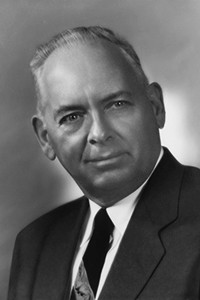 Charles R. Sattgast was born in Mount Vernon, Illinois on January 26, 1899. Before serving as President of Bemidji State, Sattgast served as president of Sioux Falls College from 1930-1937. Along with being a World War II veteran, Sattgast is best known for the science building named after him. During his tenure, Bemidji State expanded from a teacher’s college to one offering liberal arts and graduate studies. Additionally, the campus grew from 20 to 74 acres, making way for science, physical education, industry, arts and dormitory buildings. Enrollment was down near the 200s due in large part to World War II. By October of 1944, 360 students and faculty members were serving in the war. Sattgast took leave from the college in 1943. According to family records, Sattgast felt he needed to be a leader and join the many young Bemidji State students and faculty that were fighting for the country. While serving, Sattgast was asked to be part of a group that is now known as the Monuments Men. This group’s mission was to go out and retrieve monuments and important historical items before a raid came through. Sattgast was asked to be part of this group based on his knowledge of history and the arts. He returned safely home in 1946. Sattgast was a passionate environmentalist, saving trees on campus whenever he could and spent his leisure time gardening and collecting edible mushrooms. Sattgast was referred to as “a dreamer and immensely honest.”
Charles R. Sattgast was born in Mount Vernon, Illinois on January 26, 1899. Before serving as President of Bemidji State, Sattgast served as president of Sioux Falls College from 1930-1937. Along with being a World War II veteran, Sattgast is best known for the science building named after him. During his tenure, Bemidji State expanded from a teacher’s college to one offering liberal arts and graduate studies. Additionally, the campus grew from 20 to 74 acres, making way for science, physical education, industry, arts and dormitory buildings. Enrollment was down near the 200s due in large part to World War II. By October of 1944, 360 students and faculty members were serving in the war. Sattgast took leave from the college in 1943. According to family records, Sattgast felt he needed to be a leader and join the many young Bemidji State students and faculty that were fighting for the country. While serving, Sattgast was asked to be part of a group that is now known as the Monuments Men. This group’s mission was to go out and retrieve monuments and important historical items before a raid came through. Sattgast was asked to be part of this group based on his knowledge of history and the arts. He returned safely home in 1946. Sattgast was a passionate environmentalist, saving trees on campus whenever he could and spent his leisure time gardening and collecting edible mushrooms. Sattgast was referred to as “a dreamer and immensely honest.”
E.W. Beck, Acting President 1938
Elton Wayne Beck was acting president for the month of January after President Deputy served his last day on December 31st of 1937. Beck was a faculty member of Bemidji State prior to his month as acting president before President Sattgast came into office on February 1st of 1938.
Manfred W. Deputy, 1919-1938
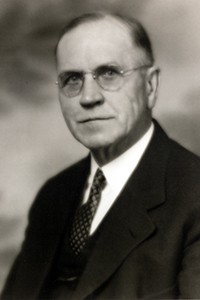 Manfred W. Deputy was born near Vernon, Indiana on October 27, 1867. All of his schooling was done in Indiana, including Southern Indiana Normal, Mitchell, Indiana University, Bloomington and Columbia University. He earned a Bachelor’s degree in philosophy and psychology, along with a Master’s degree in education. From 1905 to 1919 he taught in Indiana, Illinois, Minnesota and Missouri. Deputy moved to Bemidji in 1919 and started Bemidji State College. During Deputy’s presidency, peak enrollment was 537 during the summer session of school in 1924. During the Deputy era, the school had three main buildings: an academic building, a dormitory and a heating plant. The academic building was the main building and is now known as Deputy Hall. Deputy made a point to have a personal connection with all the students on campus. He even helped students who were struggling financially by giving them money out of his own pocket. Additionally, Deputy invited students with limited income to dinner at his house on a regular basis. He served as president for 19 years until mandatory retirement. He passed away in Lake City, Iowa on March 13, 1947.
Manfred W. Deputy was born near Vernon, Indiana on October 27, 1867. All of his schooling was done in Indiana, including Southern Indiana Normal, Mitchell, Indiana University, Bloomington and Columbia University. He earned a Bachelor’s degree in philosophy and psychology, along with a Master’s degree in education. From 1905 to 1919 he taught in Indiana, Illinois, Minnesota and Missouri. Deputy moved to Bemidji in 1919 and started Bemidji State College. During Deputy’s presidency, peak enrollment was 537 during the summer session of school in 1924. During the Deputy era, the school had three main buildings: an academic building, a dormitory and a heating plant. The academic building was the main building and is now known as Deputy Hall. Deputy made a point to have a personal connection with all the students on campus. He even helped students who were struggling financially by giving them money out of his own pocket. Additionally, Deputy invited students with limited income to dinner at his house on a regular basis. He served as president for 19 years until mandatory retirement. He passed away in Lake City, Iowa on March 13, 1947.
